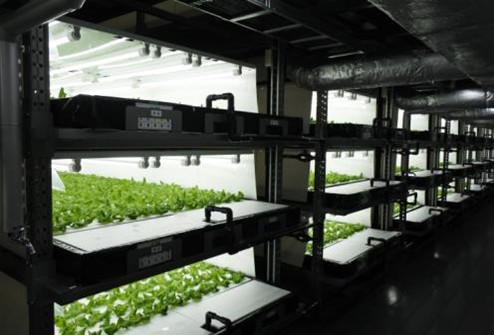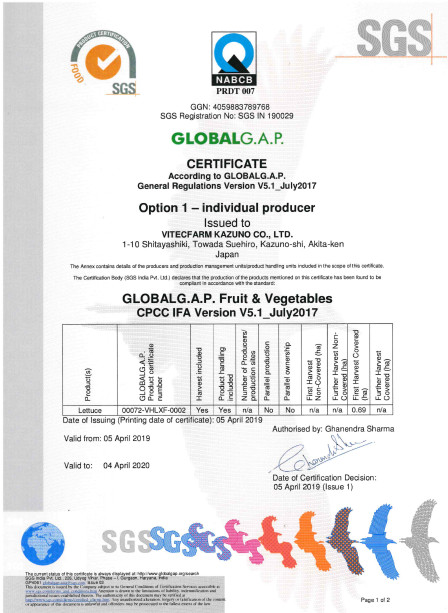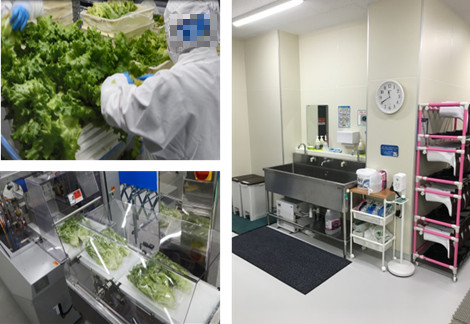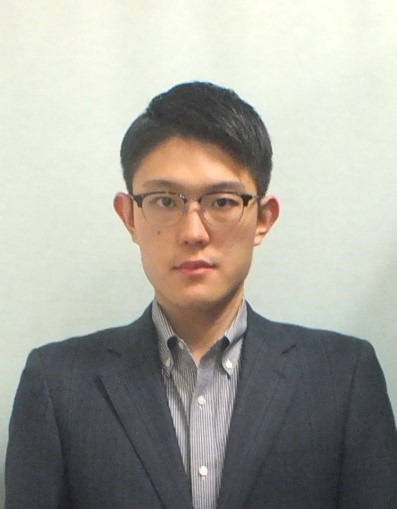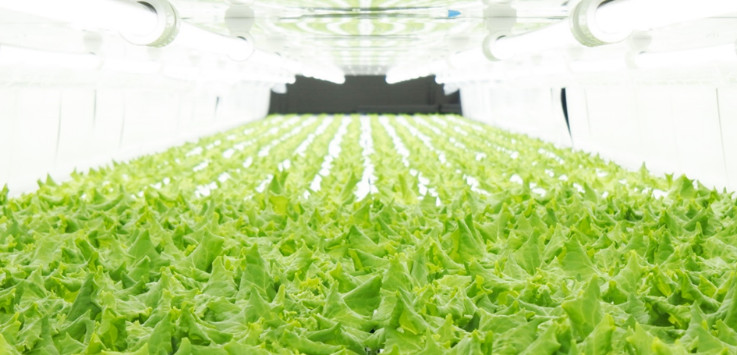
GFSI Japan Local Group Communication WG (GFSI): We spoke with Takao Akita, Executive Officer of Vitec Vegetable Factory Co., Ltd., one of the largest plant factory operators in Japan, which obtained GLOBALG.A.P. for all 5 factories in Japan.
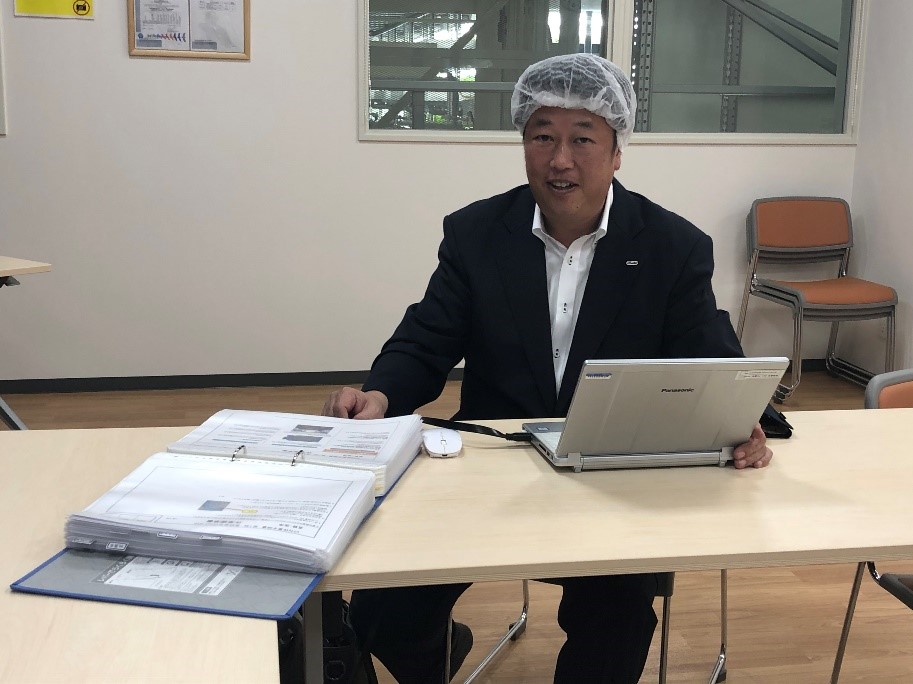
Vitec Vegetable Factory Co., Ltd. (VVF): Our parent company is Restar Holdings Corporation (HQ: Shinagawa-ku, Tokyo) which handles electronics in general, and we entered the agricultural business in 2015 as a new business pillar. We are currently operating plant factories in five locations in Japan including Akita Prefecture, home to our Odate Plant. We artificially control the environment in these plants including factors such as temperature, humidity, and light which results in a closed ecosystem. We mainly produce leaf vegetables at our factories.
Year Each Factory Acquired GLOBALG.A.P Certification
| Factory Name | Location | Start Date | Year of Certification |
| Odate Factory | Odate-shi, Akita | April 2016 | 2018 |
| Nanao Factory | Nanao-shi, Ishikawa | September 2017 | |
| Satsuma-Sendai Factory | Satsuma sendai-shi, Kagoshima | November 2017 | |
| Nakanoto Factory | Kashima-gun, Ishikawa | May 2018 | |
| Kazuno Factory | Kazuno-shi, Akita | December 2018 | 2019 |
GFSI: Why did you enter the plant factory business?
VVF: Currently, the size of the Japanese market for leaf vegetables is estimated to be 600,000 tons per year. 99% of the market is currently supplied by open cultivation. In contrast, the production of plant factories is estimated to be less than 10,000 tons a year in Japan.
Vegetable production in plant factories is characterised by its “stable supply throughout the year”, “safe and secure vegetables without pesticides”, and “no insect contamination”. Many of plant factory vegetables are sold alongside ordinary leaf vegetables on shelves of retail stores such as supermarkets. Plant factory vegetables are sold as high added-value products like “low potassium vegetables.”
However, plant factory vegetables have not yet been used outside of retail for commercial purposes such as convenience store sandwiches, 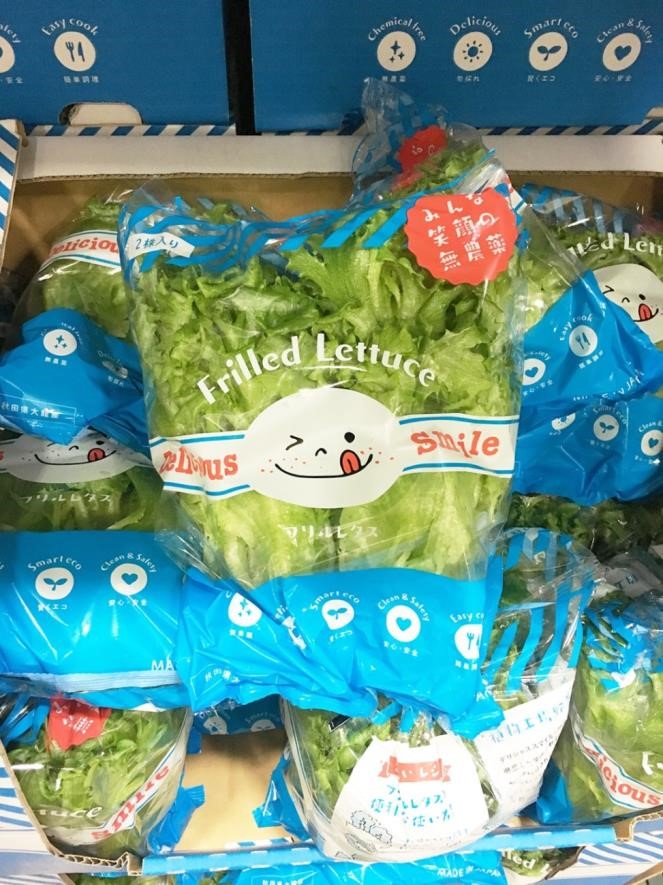
In the future, we plan to increase the number of factories and to expand production scale to 10,000 tons per year by 2022. We have received investment from a variety of companies, including machinery manufacturers, IT companies, logistics companies, and food manufacturers. We are working to expand our production sites based on a franchise system, to establish food processing factories, and to expand the range of cultivated items such as western vegetables and strawberries.
GFSI: Your ability to expand your business through such a large production scale sets you apart from other existing businesses. Please tell us how you went about acquiring GLOBALG.A.P. certification in only two years, from 2018 to present.
VVF: We focused on “raw material production” in the early stages of starting a business. This is the case of our “first generation” factories including the Odate Factory, Nanao Factory and Satsuma-Sendai Factory.
Our “second generation” of factories, the Nakanoto Factory (Ishikawa Prefecture) and the Kazuno Factory (Akita Prefecture), were launched as “food manufacturing factories” with of the goal of supplying major retail chains. In order to do business with a major retail chain, high levels of safety management and quality control are required, and we saw a need to raise the level of our factories’ safety and quality to that of a general food factory. This was the inspiration behind our efforts to achieve GLOBALG.A.P. certification.
In June 2017, we established a project team in charge of acquiring GLOBALG.A.P. certification. The Odate Factory gained certification in May 2018, and by 2019 all five factories had followed suit. The first four factories (Odate, Nanao, Satsuma-Sendai, and Nakanoto) have already passed their renewal audits for 2019.
GFSI: What difficulties did you face that were unique to a plant factory?
VVF: The first difficulty was the preparation of a manual for hygiene management. There were no such existing manuals that could serve as a reference because acquiring GLOBALG.A.P. certification in a closed plant factory is a rare case even throughout the world. We had an pre-existing standard work manual, but it provided only a rough explanation of harvesting methods. Based on the standard requirements of GLOBALG.A.P., we clarified the environmental and qualitative risks that could occur in the factory and integrated them into one manual, all the while receiving advice from experts on how to handle them.
Another major difficulty lay in distributing the manuals among and providing education to our employees. The electronics industry faces stricter standards than the agriculture industry, including ISO, and as a company we have a lot of experience in complying with such strict standards. However, in the early stages of entering the plant factory business, there were no rules, and the situation was like seeding and harvesting based on experience and intuition. Under such circumstances, it was difficult to properly address quality control and employee hygiene management in a manual. We invited experts to hold a monthly study session to promote the spread of use of the manual and raise awareness among employees.
GFSI: Were there any advantages you had as a plant factory in the certification process?
VVF: We dealt less with issues regarding agrichemicals. We don’t use agrichemicals in our plant factories, and we were able to skip around 100 items related to agrichemicals in the audit.
GFSI: Certification for a closed plant factory is a unique case, and you succeeded through a process of trial and error. What are the effects after acquiring certification?
VVF: There have been four major effects. Firstly, we have seen a decrease in the workload that was traditionally involved with responding to audits by business partners. As I mentioned earlier, we need to clear various strict requirements in order to do business with major retail chains. However, the standards set by GLOBALG.A.P. are common to the requirements by these chains. Through gaining certification, we were exempted from audits of these items, which resulted in a reduction of the workload involved with making individual responses.
Second, we have seen a reduction to administrative burden through standardisation. Since we obtained GLOBALG.A.P. certification in all five of our plants in Japan, we were able to standardise management among all plants such as quality control and risk management. As a result, many of the management operations in each plant could be consolidated into one location, and the number of people involved in management operations were reduced.
Third, we have seen an improvement in employees awareness. GLOBALG.A.P. certification is updated every two years, so each employee is working on daily records and management with a sense of tension. Also, the fact that we have continued to maintain this international certification has resulted in a boost of employee confidence.
Lastly, the accumulation of daily records in order to maintain our status of certification has been stored as a valuable dataset that can be used in the future. Such data could be used as material for reflection when some sort of risk occurs, or potentially even as “big data”. We plan to further promote the introduction of robots, AI, and IoT to our factories in the future. The data recorded based on standards of GLOBALG.A.P. could possibly serve as the basic data for AI in our factories. For example, if data regarding damage or waste of materials such as scissors for harvesting is accumulated, we can forecast how many new items will be needed and when. We believe such applications of the data will reduce maintenance costs and improve the efficiency of our material inventory. If further refinement proceeds, things like automatic ordering of materials might be possible.
GFSI: Thank you. You have already brought about the realisation of large advancements, and I think in particular that your idea of “utilisation in the future” is of particular importance. In bringing the conversation back to daily quality control, are there any risks of concern unique to plant factories or anything that you particularly focus your efforts on?
VVF: Interruption of stable supply is the biggest risk. Most people don’t assume that stable is an issue among plant factories. However, there are issues concerning logistics, especially cold chains, that prove to be particularly problematic in stable supply. In the case of general food factories which ship to convenience store chains, the cold chain is not interrupted basically because the goods are moved in the logistics network of the chain. However, maintaining the cold chain is a big issue for us because we are working on the construction of a logistics network independently. For this reason, we are working to build our own routes for our plant factories and to build storage systems at distribution centers in cooperation with logistics and distribution companies who have invested in us.
For lettuce, temperature control is important for storage and transport after harvesting. It is important not only to simply keep low temperature but also to minimise changes in temperature. We manage temperature changes within 5 degrees Celsius between storage and transport after harvesting.
We are also working on breeding. In light of recent trends for food loss reduction, convenience store chains are working to extend the expiration dates of products such as salads or sandwiches as much as possible. In addition to building the cold chain as I mentioned earlier, we introduced new varieties to extend the freshness of the products. In the case of normal lettuce, the stem part discolor changes in color after 17 hours at room temperature (25 degree) and browns after 65 hours. In the case of breeds developed by our company, the stem part will not discolor even after 72 hours if kept at 4 degrees.
GFSI: How about the problem of the variability of quality in production?
VVF: For example, the Nakanoto Plant harvests 17,000 crops a day. Although the weight per crop varies slightly, partners permit some extent because it’s a crop. Rather, if the size is all the same, it is often an indicator of the occurrence of an abnormality. For example, if all crops are seeing slow growth, it indicates that equipment is failing to work properly. We monitor these growth conditions every day for 40 days from seeding to harvesting. When there is a problem in growth, we adjust the temperature, humidity, and nutrient solution concentration, to ensure the as high a quality as possible.
GFSI: Thank you very much for sharing your advanced initiatives. Finally, could you give us a message looking back on your effort for acquiring GLOBALG.A.P. certification?
VVF: We value the viewpoint of “accumulation and utilisation in the future”. There are many certifications other than GLOBALG.A.P. We were able to make safety management and quality control matters of common concern through the development of our manual, and the accumulation of data regarding our daily activities will certainly lead to the next action. In addition, I believe that the standardisation of these initiatives is not for differentiation of individual companies, but for creation of new technologies and businesses. It is certainly difficult to build management mechanisms such as safety management and quality control. However, I believe that, if those efforts spread, it will lead to the development of the plant factory industry and also the entire agricultural industry.
GFSI: Thank you for sharing your valuable story.
Subscribe to GFSI News
This article was written by:
Kohei Kishi
GFSI Japan Local Group Communication WG
Regional Industry Strategy Group, Regional Revitalization Division, Mitsubishi Research Institute, Inc.
